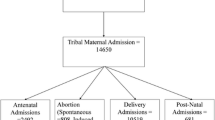Abstract
Objective
To evaluate the maternal and fetal outcome in pregnant women with sickle cell disease and to highlight the complications encountered during pregnancy and delivery at a university hospital in the Eastern Saudi Arabia.
Study design
A retrospective study of 255 pregnancies in 145 patients with sickle cell disease (SCD) over an 8-year-period analyzed the perinatal complications and maternal and fetal outcomes compared with a control group of 500 Saudi females with the normal hemoglobin phenotype selected randomly that matched for age, parity and delivered during the study period.
Results
The incidence of SCD was 1.3% of all deliveries with one maternal death (0.4%) and a perinatal mortality rate of 78.2/1,000 deliveries in the series. The major maternal complications in the 255 pregnancies were anemia 84.3%, sickle cell crisis 44.3% (26.6% painful and 17.7% hemolytic crises), infection 45.9%, fetal growth restriction 20.1%, preterm delivery 12.6%, and pregnancy-induced hypertension 10.6%. Blood transfusion was necessary in 34% pregnancies. Stillbirths accounted for 63% of the perinatal mortality.
Conclusions
Saudi women with SCD are at a greater risk of morbidity and mortality in pregnancy than previously reported, with a high perinatal mortality rate. Early booking, meticulous antenatal care and supervised hospital delivery will improve the maternal and fetal outcomes in these patients.
Similar content being viewed by others
References
Al Awamy BH, Wilson WA, Pearson HA (1984) Splenic function in sickle cell disease in the Eastern Province of Saudi Arabia. J Pediatr 104:714–719. doi:10.1016/S0022-3476(84)80950-6
Al Awamy BH, Niazi GA, El-Mouzan MI, Al Torki MT, Naeem MA (1986) Newborn screening for sickle cell hemoglobinopathy and other inherited erythrocytic disorders in the Eastern Province of Saudi Arabia. Saudi Med J 7:502–509
Dare FO, Makinde OO, Faasuba OB (1992) The obstetric performance of sickle cell disease patients and homozygous hemoglobin C patients in Ile-Ife, Nigeria. Int J Gynaecol Obstet 37:163–168. doi:10.1016/0020-7292(92)90376-T
Hassell K (2005) Pregnancy and sickle cell disease. Hematol Oncol Clin North Am 19:903–907. doi:10.1016/j.hoc.2005.07.003
Howard RJ, Tuck SM, Pearson TC (1995) Pregnancy in sickle cell disease in the UK: results of a multicentre survey of the effect of prophylactic blood transfusion on maternal and fetal outcome. Br J Obstet Gynaecol 102:947–951
Koshy M, Burd L, Wallace D, Moawad A, Baron J (1988) Prophylactic red-cell transfusion in pregnant patients with sickle cell disease: a randomized cooperative study. N Engl J Med 319:1447–1452
Milner PF, Jones BR, Dobler J (1980) Outcome of pregnancy in sickle cell anemia and sickle cell hemoglobin C disease. Am J Obstet Gynecol 138:239–245
Morris JS, Dunn DT, Poddar D, Serjeant GR (1994) Haematological risk factors for pregnancy outcome in Jamaican women with homozygous sickle cell disease. Br J Obstet Gynaecol 101:770–773
Morrison JC, Whybrew WD, Bucovaz ET (1978) Use of partial transfusion preoperatively in patients with sickle cell hemoglobinopathies. Am J Obstet Gynecol 132:59–63
Mulik R, Butikofer A, Aramouni G, Munshi N, Iliff P (1991) A clinico-epidemiological study of sickle cell anaemia in Saudi Arabia. J Trop Pediatr 37(3):100–105
Odum CU, Anorlu RI, Dim SI, Oyekan TO (2002) Pregnancy outcome in HbSS–sickle cell disease in Lagos, Nigeria. West Afr J Med 21:19–23
Ogedenghe OK, Akinyanju O (1993) The pattern of sickle cell disease in pregnancy in Lagos, Nigeria. West Afr J Med 12:96–100
Omo-Aghoja IO, Okonofua FE (2007) Pregnancy outcome in women with sickle cell–a five year review. Niger Postgrad Med J 14:151–154
Padmos MA, Roberts GT, Sackey K, Kulozik A, Bail S, Morris JS, Serjeant BE, Serjeant GR (1991) Two different forms of homozygous sickle cell anaemia in Saudi Arabia. Br J Haematol 79:93–98. doi:10.1111/j.1365-2141.1991.tb08013.x
Perrine RP, John P (1974) Pregnancy in sickle cell anemia in a Caucasian group. Am J Obstet Gynecol 118:29–31
Perrine RP, Pembrey ME, John P, Perrine S, Shoup F (1978) Natural history of sickle cell anemia in Saudi Arabia. A study of 270 subjects. Ann Intern Med 88:1–6
Poddar D, Maude GH, Plant MJ, Scorer H, Serjeant GR (1986) Pregnancy in Jamaican women with homozygous sickle cell disease: fetal and maternal outcome. Br J Obstet Gynaecol 93:727–732
Rahimy MC, Gangbo A, Adjou R, Deguenon C, Goussanou S, Alihonou E (2000) Effect of active prenatal management on pregnancy outcome in sickle cell disease in an African setting. Blood 96:1685–1689
Serjeant GR, Ascheroft MT, Serjeant BE (1973) Clinical features of hemoglobin in sickle cell disease in Jamaica. Br J Haematol 24:491–495. doi:10.1111/j.1365-2141.1973.tb01675.x
Serjeant GR, Loy LL, Crowther M, Hambleton IR, Thame M (2004) Outcome of pregnancy in homozygous sickle cell disease. Obstet Gynecol 103:1278–1285
Smith JA, Espeland M, Bellevue R, Bonds D, Brown AK, Koshy M (1996) Pregnancy in sickle cell disease: experience of the cooperative study of sickle cell disease. Obstet Gynecol 87:199–204. doi:10.1016/0029-7844(95)00367-3
Sun PM, Wilburn W, Raynor BD, Jamieson D (2001) Sickle cell disease in pregnancy: twenty years of experience at Grady Memorial Hospital, Atlanta, Georgia. Am J Obstet Gynecol 184:1127–1130. doi:10.1067/mob.2001.115477
Thame M, Lewis J, Trotman H et al (2007) The mechanisms of low birth weight in infants of mothers with homozygous sickle cell disease. Pediatrics 120:e686. doi:10.1542/peds.2006-2768
Villers MS, Jamison MG, Castro LM, James AH (2008) Morbidity associated with sickle cell disease in pregnancy. Am J Obstet Gynecol 199:125–130. doi:10.1016/j.ajog.2008.04.016
Author information
Authors and Affiliations
Corresponding author
Rights and permissions
About this article
Cite this article
Al Jama, F.E., Gasem, T., Burshaid, S. et al. Pregnancy outcome in patients with homozygous sickle cell disease in a university hospital, Eastern Saudi Arabia. Arch Gynecol Obstet 280, 793–797 (2009). https://doi.org/10.1007/s00404-009-1002-7
Received:
Accepted:
Published:
Issue Date:
DOI: https://doi.org/10.1007/s00404-009-1002-7




